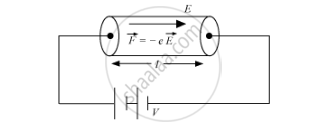Advertisements
Advertisements
प्रश्न
Derive an expression for drift velocity of free electrons.
Derive an expression for drift velocity of electrons in a conductor. Hence deduce Ohm's law.
उत्तर
(i) Free electrons are in continuous random motion. They undergo change in direction at each collision and the thermal velocities are randomly distributed in all directions.
∴ Average thermal velocity,`u=(u_1+u_2+....+u_n)/n " is Zero".....(1)`

The electric field E exerts an electrostatic force ‘−Ee’.
Acceleration of each electron is,`veca=(-evecE)/m " ......(2)"`
Where,
m → Mass of an electron
e → Charge on an electron
Drift velocity,
`vec(v_d)=(vec(v_1)+vec(v_2)+....+vec(v_n))/n`
`vec(v_d)=((vec(u_1)+vecat_1)+(vec(u_2)+vecat_2)+....+(vec(u_n)+vecat_n))/n`
Where,
`vecu_1,vecu_2->` Thermal velocities of the electrons
`vecatau_1,vecatau_2->` Velocity acquired by electrons
τ1, τ2 → Time elapsed after the collision
`vec(v_d)=((vec(u_1)+vec(u_2)+...+vecu_n))/n+(veca(vec(t_1)+vec(t_2)+...vec(t_n)))/n`
Since `(vec(u_1)+vec(u_2)+....vec(u_n))/n=0`
∴ vd = a τ
Where,`t=(t_1+t_2+t_3....t_n)/n " is the average time elapsed"`
Substituting for a from equation (2),
`vec(v_d)=(-evecE)/mt " ...(4)"`
As, `E=V/l`
From (4) we can write
`v_d=(eV)/(ml)τ`
Also,
`I=An""ev_d`
Therefore,
`I=An""e((eV)/(ml)τ)=(An""e^2τ)/(ml) V`
`or V/I=(ml)/(An""e^2τ)=R` .... (5)
As we can see all the parameter on the R.H.S of the equation 5 are constant given temperature. And it is known as Resistance of the electric conductor.
APPEARS IN
संबंधित प्रश्न
The number density of free electrons in a copper conductor is 8.5 × 1028 m−3. How long does an electron take to drift from one end of a wire 3.0 m long to its other end? The area of cross-section of the wire is 2.0 × 10−6 m2 and it is carrying a current of 3.0 A.
Define relaxation time of the free electrons drifting in a conductor. How is it related to the drift velocity of free electrons? Use this relation to deduce the expression for the electrical resistivity of the material.
When a current is established in a wire, the free electrons drift in the direction opposite to the current. Does the number of free electrons in the wire continuously decrease?
A current of 1.0 A exists in a copper wire of cross-section 1.0 mm2. Assuming one free electron per atom, calculate the drift speed of the free electrons in the wire. The density of copper is 9000 kg m–3.
Consider the following statements.
(A) Free-electron density is different in different metals.
(B) Free-electron density in a metal depends on temperature.
Peltier Effect is caused _______________ .
Consider the following statements.
(A) Free-electron density is different in different metals.
(B) Free-electron density in a metal depends on temperature.
Thomson Effect is caused _______________ .
Obtain the expression for the current flowing through a conductor having number density of the electron n, area of cross-section A in terms of the drift velocity vd .
When a current I is set up in a wire of radius r, the drift velocity is vd· If the same current is set up through a wire of radius 2 r, the drift velocity will be:
Is the momentum conserved when charge crosses a junction in an electric circuit? Why or why not?
The potential difference applied across a given conductor is doubled. How will this affect (i) the mobility of electrons and (ii) the current density in the conductor? Justify your answers.
